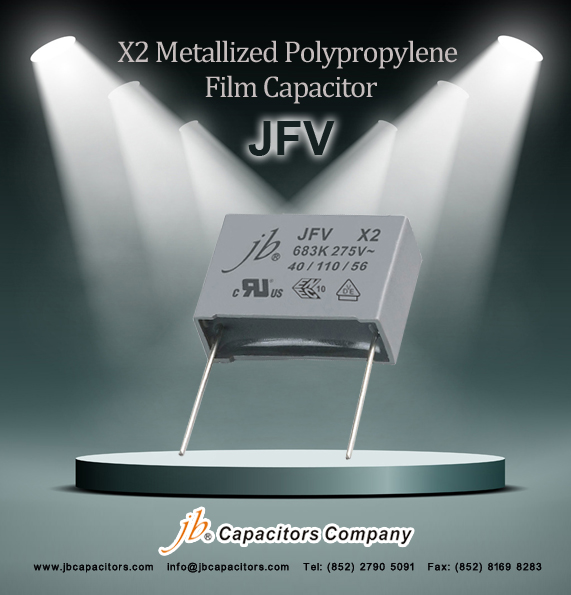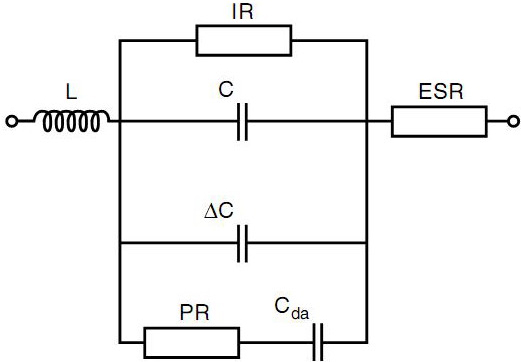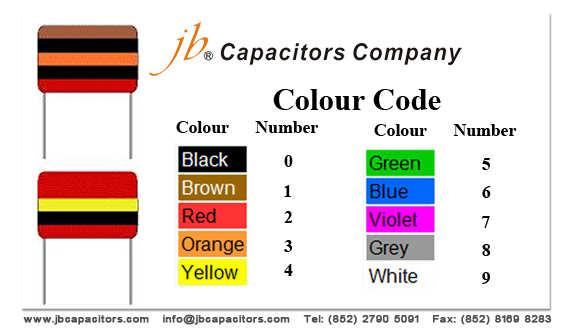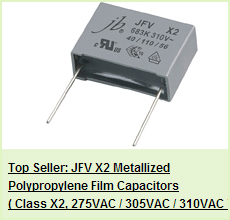2011-3-21 16:59:0
views
Au département d'achat ou de vente:
Comment allez-vous ?
Maintenant nous sommes foyer sur favoriser notre série de JFV ! Cette série est pour le marché d'oversea, et employé couramment en ballasts électroniques, ventilateurs, éclairage, mètre de puissance, fournisseurs de puissance….application partout dans le monde. Achetez-vous des condensateurs du film X2 ? Bienvenue pour nous envoyer l'enquête et pour vérifier nos prix. Merci.
Série de JFV--Condensateurs de film de polypropylène métallisés par X2
Approbation de sûreté : Approbations de la CE et de TUV et d'UL.
Chaîne de capacité : 1000pF~2.2uF
Correspondance: Panasonic ECQU, Vishay MKP3382 275Vac, Wima MP3, Arcotronics R46, Pilkor PCX2 337,Epcos B81130, Evox Rifa PHE840M.
Délai d'exécution court : environ 5~7 semaines
Datasheet: http://www.jbcapacitors.com/pdf/JFV-X2-Metallized-Polypropylene-Film-Capacitor.pdf

2011-3-18 2:13:31
views
rated capacitance (cr)
The rated capacitance of a capacitor is the value which is indicated upon it. The capacitance is measured at 1 kHz and +23°C.
rated voltage (ur)
The rated voltage is the maximum direct voltage or the maximum RMS alternating voltage which may be applied continuously to the terminals of the capacitor at any temperature within the rated temperature range.
2011-3-17 2:24:19
views

C = nominal value of the capacitor
L = inductance (leads, metallization, winding)
ESR = equivalent series resistance (leads, metallization, metal spraying)
IR = insulation resistance (properties of the dielectric material)
∆C = capacitance change (depending on changes in temperature, DC voltage and/or frequency)
PR = dielectric polarization resistance
Cda = dielectric absorption
2011-3-16 2:26:9
views
Capacitors loaded with pulses with fast rise or fall times (high dU/dt) will be exposed to high current pulses. In order not to overload the internal connections the current must be limited. The current limits for a specifc type are dependent upon:
- Amplitude and form of the pulse
- Rated voltage of the capacitor
- Capacitance
- Geometrical configuration of the winding
dU/dt = UR/(R x C)
UR = Rated voltage
R = Discharge resistor
C = Rated capacitance
2011-3-15 2:27:44
views
The reliability of a capacitor is mainly a function of:
- The construction; dielectric material and its thickness
- The manufacturing process
- The application; electrical stress and temperature
2011-3-11 12:1:55
views
A colour code was used on polyester capacitors for many years. It is now obsolete, but of course there are many still around. The colours should be read like the resistor code, the top three colour bands giving the value in pF. Ignore the 4th band (tolerance) and 5th band (voltage rating).

For example:brown, black, orange means 10000pF = 10nF = 0.01µF.
Note that there are no gaps between the colour bands, so 2 identical bands actually appear as a wide band.
For example:wide red, yellow means 220nF = 0.22µF.
2011-3-10 11:55:49
views
Capacitors in a parallel configuration each have the same applied voltage. Their capacitances add up. Charge is apportioned among them by size. Using the schematic diagram to visualize parallel plates, it is apparent that each capacitor contributes to the total surface area.

Ceq=C1+C2+……+Cn
2011-3-8 15:36:54
views
Basically the SMD series have the same electrical characteristics as the analogous through-hole WIMA capacitors. Compared to ceramic or tantalum dielectrics WIMA SMD capacitors have a number of other outstanding qualities:
- favourable pulse rise time
- low ESR
- low dielectric absorption
- available in high voltage series
- large capacitance spectrum
- stand up to high mechanical stress
- good long-term stability
2011-3-2 10:41:58
views
The capacitors are usable for radial manual insertion on PCB. The fixation on the board by double kinked leads prevents that the component jumps out of the PCB during transport.
The components with lead diameter of 0.6 mm are usable for being inserted in punched holes with nominal diameter of 0.8 mm and the components with lead diameter of 0.8 mm are usable for being inserted in punched holes with nominal diameter of 1.0 mm.
The pitch is specified on the top of the leads. After manufacturing, the products meet the specification. Although special care is taken to the packaging, deviations may occur due to transport.
2011-2-26 16:40:12
views
To use this table, just read across. For example, 1uF is same 1,000nF or 1,000,000pF.
| uF/ MFD | nF | pF/ MMFD | | uF/ MFD | nF | pF/ MMFD |
| 1uF / MFD | 1000nF | 1000000pF(MMFD) | | 0.001uF / MFD | 1nF | 1000pF(MMFD) |
| 0.82uF / MFD | 820nF | 820000pF (MMFD) | | 0.00082uF / MFD | 0.82nF | 820pF (MMFD) |
| 0.8uF / MFD | 800nF | 800000pF (MMFD) | | 0.0008uF / MFD | 0.8nF | 800pF (MMFD) |
| 0.7uF / MFD | 700nF | 700000pF (MMFD) | | 0.0007uF / MFD | 0.7nF | 700pF (MMFD) |
| 0.68uF / MFD | 680nF | 680000pF (MMFD) | | 0.00068uF / MFD | 0.68nF | 680pF (MMFD) |
| 0.6uF / MFD | 600nF | 600000pF (MMFD) | | 0.0006uF / MFD | 0.6nF | 600pF (MMFD) |
| 0.56uF / MFD | 560nF | 560000pF (MMFD) | | 0.00056uF / MFD | 0.56nF | 560pF (MMFD) |
| 0.5uF / MFD | 500nF | 500000pF (MMFD) | | 0.0005uF / MFD | 0.5nF | 500pF (MMFD) |
| 0.47uF / MFD | 470nF | 470000pF (MMFD) | | 0.00047uF / MFD | 0.47nF | 470pF (MMFD) |
| 0.4uF / MFD | 400nF | 400000pF (MMFD) | | 0.0004uF / MFD | 0.4nF | 400pF (MMFD) |
| 0.39uF / MFD | 390nF | 390000pF (MMFD) | | 0.00039uF / MFD | 0.39nF | 390pF (MMFD) |
| 0.33uF / MFD | 330nF | 330000pF (MMFD) | | 0.00033uF / MFD | 0.33nF | 330pF (MMFD) |
| 0.3uF / MFD | 300nF | 300000pF (MMFD) | | 0.0003uF / MFD | 0.3nF | 300pF (MMFD) |
| 0.27uF / MFD | 270nF | 270000pF (MMFD) | | 0.00027uF / MFD | 0.27nF | 270pF (MMFD) |
| 0.25uF / MFD | 250nF | 250000pF (MMFD) | | 0.00025uF / MFD | 0.25nF | 250pF (MMFD) |
| 0.22uF / MFD | 220nF | 220000pF (MMFD) | | 0.00022uF / MFD | 0.22nF | 220pF (MMFD) |
| 0.2uF / MFD | 200nF | 200000pF (MMFD) | | 0.0002uF / MFD | 0.2nF | 200pF (MMFD) |
| 0.18uF / MFD | 180nF | 180000pF (MMFD) | | 0.00018uF / MFD | 0.18nF | 180pF (MMFD) |
| 0.15uF / MFD | 150nF | 150000pF (MMFD) | | 0.00015uF / MFD | 0.15nF | 150pF (MMFD) |
| 0.12uF / MFD | 120nF | 120000pF (MMFD) | | 0.00012uF / MFD | 0.12nF | 120pF (MMFD) |
| 0.1uF / MFD | 100nF | 100000pF (MMFD) | | 0.0001uF / MFD | 0.1nF | 100pF (MMFD) |
| 0.082uF / MFD | 82nF | 82000pF (MMFD) | | 0.000082uF / MFD | 0.082nF | 82pF (MMFD) |
| 0.08uF / MFD | 80nF | 80000pF (MMFD) | | 0.00008uF / MFD | 0.08nF | 80pF (MMFD) |
| 0.07uF / MFD | 70nF | 70000pF (MMFD) | | 0.00007uF / MFD | 0.07nF | 70pF (MMFD) |
| 0.068uF / MFD | 68nF | 68000pF (MMFD) | | 0.000068uF / MFD | 0.068nF | 68pF (MMFD) |
| 0.06uF / MFD | 60nF | 60000pF (MMFD) | | 0.00006uF / MFD | 0.06nF | 60pF (MMFD) |
| 0.056uF / MFD | 56nF | 56000pF (MMFD) | | 0.000056uF / MFD | 0.056nF | 56pF (MMFD) |
| 0.05uF / MFD | 50nF | 50000pF (MMFD) | | 0.00005uF / MFD | 0.05nF | 50pF (MMFD) |
| 0.047uF / MFD | 47nF | 47000pF (MMFD) | | 0.000047uF / MFD | 0.047nF | 47pF (MMFD) |
| 0.04uF / MFD | 40nF | 40000pF (MMFD) | | 0.00004uF / MFD | 0.04nF | 40pF (MMFD) |
| 0.039uF / MFD | 39nF | 39000pF (MMFD) | | 0.000039uF / MFD | 0.039nF | 39pF (MMFD) |
| 0.033uF / MFD | 33nF | 33000pF (MMFD) | | 0.000033uF / MFD | 0.033nF | 33pF (MMFD) |
| 0.03uF / MFD | 30nF | 30000pF (MMFD) | | 0.00003uF / MFD | 0.03nF | 30pF (MMFD) |
| 0.027uF / MFD | 27nF | 27000pF (MMFD) | | 0.000027uF / MFD | 0.027nF | 27pF (MMFD) |
| 0.025uF / MFD | 25nF | 25000pF (MMFD) | | 0.000025uF / MFD | 0.025nF | 25pF (MMFD) |
| 0.022uF / MFD | 22nF | 22000pF (MMFD) | | 0.000022uF / MFD | 0.022nF | 22pF (MMFD) |
| 0.02uF / MFD | 20nF | 20000pF (MMFD) | | 0.00002uF / MFD | 0.02nF | 20pF (MMFD) |
| 0.018uF / MFD | 18nF | 18000pF (MMFD) | | 0.000018uF / MFD | 0.018nF | 18pF (MMFD) |
| 0.015uF / MFD | 15nF | 15000pF (MMFD) | | 0.000015uF / MFD | 0.015nF | 15pF (MMFD) |
| 0.012uF / MFD | 12nF | 12000pF (MMFD) | | 0.000012uF / MFD | 0.012nF | 12pF (MMFD) |
| 0.01uF / MFD | 10nF | 10000pF (MMFD) | | 0.00001uF / MFD | 0.01nF | 10pF (MMFD) |
| 0.0082uF / MFD | 8.2nF | 8200pF (MMFD) | | 0.0000082uF / MFD | 0.0082nF | 8.2pF (MMFD) |
| 0.008uF / MFD | 8nF | 8000pF (MMFD) | | 0.000008uF / MFD | 0.008nF | 8pF (MMFD) |
| 0.007uF / MFD | 7nF | 7000pF (MMFD) | | 0.000007uF / MFD | 0.007nF | 7pF (MMFD) |
| 0.0068uF / MFD | 6.8nF | 6800pF (MMFD) | | 0.0000068uF / MFD | 0.0068nF | 6.8pF (MMFD) |
| 0.006uF / MFD | 6nF | 6000pF (MMFD) | | 0.000006uF / MFD | 0.006nF | 6pF (MMFD) |
| 0.0056uF / MFD | 5.6nF | 5600pF (MMFD) | | 0.0000056uF / MFD | 0.0056nF | 5.6pF (MMFD) |
| 0.005uF / MFD | 5nF | 5000pF (MMFD) | | 0.000005uF / MFD | 0.005nF | 5pF (MMFD) |
| 0.0047uF / MFD | 4.7nF | 4700pF (MMFD) | | 0.0000047uF / MFD | 0.0047nF | 4.7pF (MMFD) |
| 0.004uF / MFD | 4nF | 4000pF (MMFD) | | 0.000004uF / MFD | 0.004nF | 4pF (MMFD) |
| 0.0039uF / MFD | 3.9nF | 3900pF (MMFD) | | 0.0000039uF / MFD | 0.0039nF | 3.9pF (MMFD) |
| 0.0033uF / MFD | 3.3nF | 3300pF (MMFD) | | 0.0000033uF / MFD | 0.0033nF | 3.3pF (MMFD) |
| 0.003uF / MFD | 3nF | 3000pF (MMFD) | | 0.000003uF / MFD | 0.003nF | 3pF (MMFD) |
| 0.0027uF / MFD | 2.7nF | 2700pF (MMFD) | | 0.0000027uF / MFD | 0.0027nF | 2.7pF (MMFD) |
| 0.0025uF / MFD | 2.5nF | 2500pF (MMFD) | | 0.0000025uF / MFD | 0.0025nF | 2.5pF (MMFD) |
| 0.0022uF / MFD | 2.2nF | 2200pF (MMFD) | | 0.0000022uF / MFD | 0.0022nF | 2.2pF (MMFD) |
| 0.002uF / MFD | 2nF | 2000pF (MMFD) | | 0.000002uF / MFD | 0.002nF | 2pF (MMFD) |
| 0.0018uF / MFD | 1.8nF | 1800pF (MMFD) | | 0.0000018uF / MFD | 0.0018nF | 1.8pF (MMFD) |
| 0.0015uF / MFD | 1.5nF | 1500pF (MMFD) | | 0.0000015uF / MFD | 0.0015nF | 1.5pF (MMFD) |
| 0.0012uF / MFD | 1.2nF | 1200pF (MMFD) | | 0.0000012uF / MFD | 0.0012nF | 1.2pF (MMFD) |
| 0.001uF / MFD | 1nF | 1000pF (MMFD) | …… | 0.000001uF / MFD | 0.001nF | 1pF (MMFD) |




